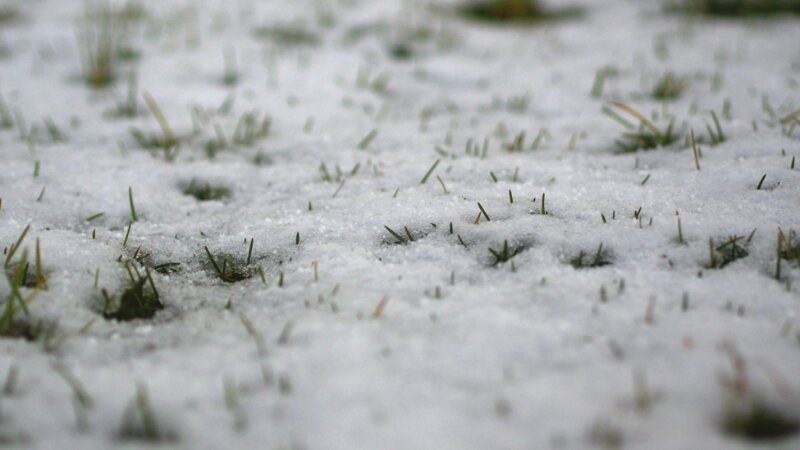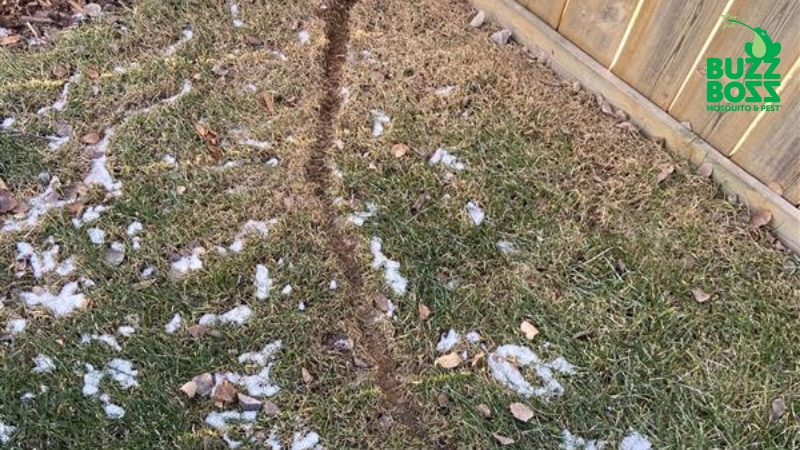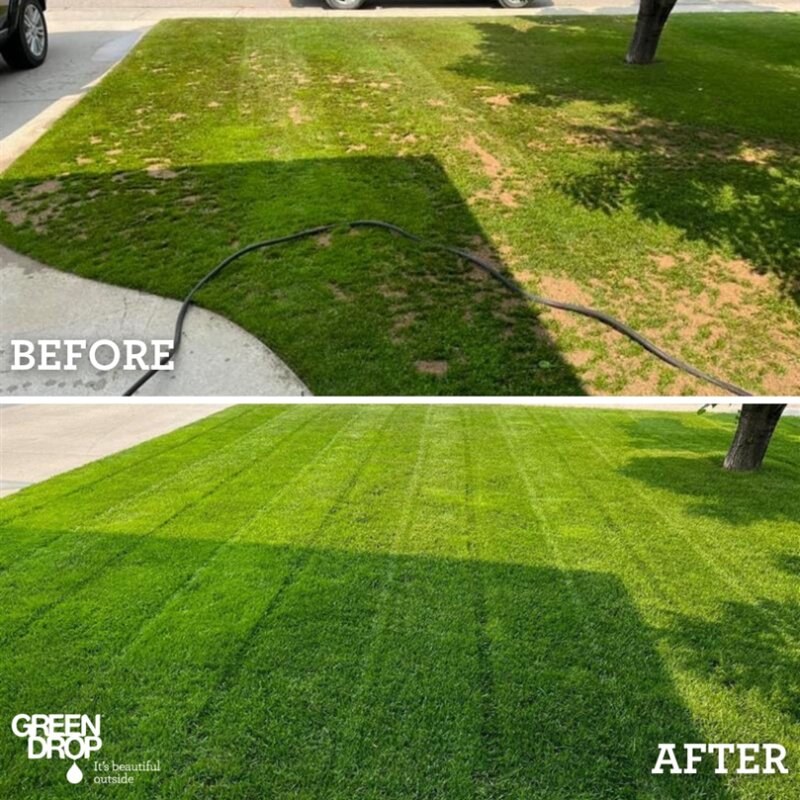How To Repair Your Red Deer Lawn From Winter Damage
Reading time: 6 minutesAs winter retreats in Red Deer, it often leaves unwanted souvenirs on your lawn, such as snow mould, frost heave, and ice damage.
If your grass seems to be sending out an SOS rather than springing to life, fear not; we’re here to help you jump-start its recovery.

Assessing the Damage
As the snow melts away, it’s time to don your detective hat and give your lawn a thorough check-up. First things first, take a good look at your lawn. Are there bare spots where the grass has said goodbye? Do you see areas where the turf is matted down or discoloured? These are telltale signs that your lawn struggled under the winter conditions and may need some extra love to bounce back.
Next, let’s get hands-on. Feel your lawn. Is the soil hard and compacted? This can prevent water and nutrients from penetrating and affecting the roots of your grass. Also, check for thatch (a layer of dead grass and roots that can build up at the soil surface).
A little thatch is normal, but too much can be a comfy home for pests and diseases. If things seem off, you'll also want to assess the overall soil health and maybe even take a sample for a soil test.
Common Types of Damage
Some typical snow-related, post-winter issues you might spot include:
- Snow Mould. This pesky fungus appears as grey or pink patches and thrives under snow-covered lawns, especially those that were left a bit too long in the fall.
- Salt Damage. If your lawn edges are particularly lifeless, it might be from de-icing salts. These can suck the moisture right out of your soil and grass.
- Rodent Activity. Look for trails or areas of upturned earth. Voles love to burrow under the snow, creating tunnels and possibly damaging your lawn’s roots.

Prepping for Recovery
You need a clean slate before you can nurse your lawn back to health. Here’s how to prep your lawn:
Clean Up
Start with a thorough cleanup to remove any debris, dead grass, and fallen leaves that accumulated over the winter. This not only tidies up your lawn but also ensures that treatments, such as fertilizers and seeds, reach the soil effectively.
Clearing the debris also improves air circulation and sunlight exposure to the soil, both crucial for healthy growth. Grab your rake and give your lawn a good once-over!
Testing Soil
Before you add anything to your lawn, it’s wise to know exactly what it needs. A soil test is invaluable as it reveals your soil's pH balance and nutrient levels. You can pick up a soil testing kit from your local garden centre.
Spring Lawn Care
After prepping your lawn, you want to get into core lawn care practices to ensure your grass comes back stronger and healthier than ever:
Aeration
After a long Red Deer winter, your soil is most likely compacted, which can affect the growth of new grass. Lawn aeration helps loosen the soil, allowing air, water, and nutrients to penetrate deeper, reaching the grass roots where they're needed most.
Overseeding
Thick, lush grass is the best defence against weeds and disease. Overseeding can help achieve this by filling in thin or bare spots, which are common after winter. Select a grass seed that matches your existing lawn type.
When overseeding, we need to focus on good seed-to-soil contact by raking lightly after spreading the seeds. Use a spreader for even seed distribution and follow up by lightly compacting the area with a roller. This will help protect the seeds from birds and ensure they aren’t washed away by rain.
Fertilizing
The results from your soil test will guide your lawn fertilizing regimen. Choose a fertilizer that complements the specific needs of your soil and grass type. For spring recovery, look for a formula with slow-release nitrogen, which ensures a steady supply of nutrients.
The slow-release formula also supports sustained growth over time. This is crucial for recovery after winter. Apply fertilizer according to the product’s instructions, typically during the growing season when your lawn is actively absorbing nutrients.
Watering
Proper watering is important for reviving your lawn. Overwatering can be as harmful as underwatering, leading to shallow root systems and increased susceptibility to disease. Go for a watering schedule that allows for deep, infrequent watering. This encourages deeper root growth, making your lawn more drought-resistant and robust.
The best time to water is early in the morning, which reduces evaporation and ensures the water soaks into the soil. We need to aim for about an inch of water per week, factoring in rainfall.
Deal with Persistent Issues Proactively
After a harsh winter, your lawn might be more susceptible to weeds, diseases, and pests, which can capitalize on the weakened state of your grass.
Weed Control
Spring is prime time for weeds to pop up. Start by thoroughly inspecting your lawn to identify any unwanted plants.
Common weeds in Red Deer include dandelions, clover and thistle. We need to nip these in the bud. Your best defence against weed invasions is maintaining a healthy, dense lawn through proper feeding, mowing, and watering.
Disease Management
Keep an eye out for signs of lawn diseases, such as discolored patches, slimy areas, or spots on grass blades. Common lawn diseases such as snow mould can appear after snow melts. If you spot these signs, applying an appropriate fungicide can help manage the issue.
However, ensuring proper drainage, avoiding excessive watering, and removing thatch can prevent many diseases from taking hold.
Pest Control
Chinch bugs and other lawn pests can damage your lawn by feeding on grass roots, leading to patches of dead or dying grass. Identify pest problems early by looking for irregularly shaped, discoloured, or wilted patches that pull up easily.
If you discover a pest issue, seek safe, environmentally friendly pest control options or seek advice from the experts.
Spot Repairs and Patch Management
Sometimes, you’ll see unsightly bare spots on your lawn where grass has become bare/discoloured or soil has eroded. You want to address these patches promptly and prevent further degradation.
- Select a grass seed that matches your existing lawn and is well-suited to the climate in Red Deer. For patches, look for quick-establishing, hardy varieties that can integrate seamlessly with your current turf. Consider a seed mix that includes a blend of different species appropriate for varying conditions (sun, shade, etc.).
- Prepare and sow the seeds evenly across the prepared area, ensuring good seed-to-soil contact—this is crucial for germination. You can add a little topsoil and lightly rake the seeds into the top layer of the lawn or use a roller to press them down. This also helps protect the seeds from birds and the wind.
- Water the patched area gently but consistently, keeping the soil slightly moist to encourage seed germination and growth. Avoid overwatering, which can wash away seeds or create soggy conditions that hinder root development. Once the new grass starts to grow, you can reduce the frequency of watering to encourage deeper root growth.
- As the new grass is established, keep the area free from foot traffic and continue regular maintenance. This includes light mowing once the grass reaches a mowing height and gradual integration into your regular lawn care routine, such as fertilizing and aeration.

Green Drop is Rooting for Your Lawn
Just like a fine wine, a great lawn doesn't come overnight. Patience and consistency are your best friends in nurturing your Red Deer lawn back to its prime.
Remember, every seed planted, every patch mended, and every weed thwarted is a step closer to your green paradise.
If you're feeling overwhelmed, don't do it alone! Select a lawn care package that best suits your needs. We’re here to help turn your lawn care woes into wows!
Green Drop provides lawn care services in Red Deer and across Western Canada in Calgary, Edmonton, Regina, Saskatoon, and Winnipeg.

